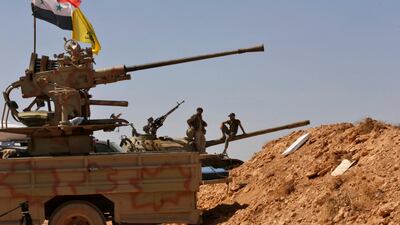Iranian involvement in the Syrian civil war can be traced to 2011, when Hezbollah snipers were bought in to help quash protests. The pretext for their initial deployment of Iranian backed militias was the defence of important Shia sites across Syria, such as the Sayyida Zainab shrine in Damascus. As the war dragged on, and began to enter its second and third years, the Al Assad regime was plagued by battlefield losses and defections. It became more heavily reliant on militias, often those trained and organised by its staunch ally Iran.
Hezbollah – the Lebanese group have been active in Syria since the early months of the conflict. Hassan Nasrallah officially acknowledged this involvement in April 2013. Though initially in Syria in an advisory role, the group's involvement deepened throughout 2013, when they played a critical role in a major offensive on the town of Al Qusayr. Last year, US officials claimed the group had around 7,000 fighters in Syria, and officials believe that some 1500 of the group’s fighters have been killed during the conflict. The group's bases, and convoys in Syria have been on the receiving end of Israeli airstrikes on several occasions in past years.
Asa'ib Ahl al-Haq - League of the Righteous, are an Iraqi militia, led by firebrand cleric Qais Al Khazali, a former US prisoner who is close to Qassem Soleimani, head of the Iranian Revolutionary Guard Corps' (IRGC) foreign wing, the Quds Force. The group recruit from Shia neighbourhoods of Baghdad, and from Najaf and Basra, they have been deployed in Syria to both Aleppo and Damascus. New recruits are reportedly taken to Iran for several weeks of training upon signing up, whilst the Iranian government reportedly offers up to $5,000 towards burial costs for those killed fighting in the Syrian conflict. The group claims 10,000 members, and hundreds of these are deployed in Syria at any one time.
Liwa Fatemiyoun are an Afghan militia formed in 2014 as the Al Assad regime’s manpower shortage began to seriously affecting its ability to deploy. Numbers are believed to number between 12,000-14,000 and recruitment takes places in the afghan refugee camps of eastern Iran, as well as among Afghanistan’s settled Hazara community. The group is widely believed to be trained and armed by the IRGC. The militia are often used as a first wave, or “cannon fodder”, and last year one member claimed that more than 2000 members of the Afghan militia had been killed fighting in Syria, and another 8,000 had been injured. They have been deployed throughout Syria, from the southern city of Deraa, to Aleppo in the north. They also played a significant role in the battle to recapture the ancient city of Palmyra from ISIL.
Kata'ib Hezbollah is another Iraqi militia heavily invested in Syria. With its origins in fighting the US military following the 2003 invasion, the group has since grown from a small insurgent force, to a militia numbering in the tens of thousands. Despite receiving training from Lebanese Hezbollah, they operate separately, but are fiercely committed to the Khomeinist ideology of the Iranian regime. The group claimed to have sent 1000 fighters to Aleppo in late 2015, as the siege of the city intensified, whilst it was active more recently in the fight against ISIL in the city of Albu Kamal near the Iraqi border.
_________
Read more
Iran protests turn spotlight on extent of Tehran's involvement in Syrian war
US offers $12 million for information on two senior Hizbollah members
_________

